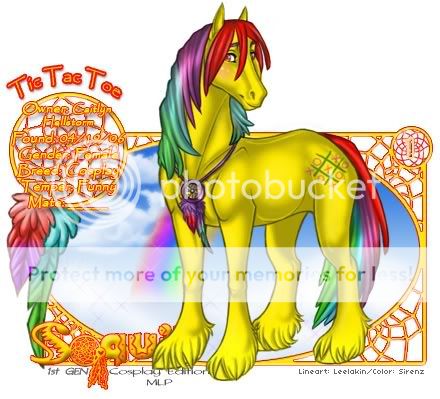Name, image, and owner(s) of mother: Succubus, owned by Meeki
 Name, image, and owner(s) of father:
Name, image, and owner(s) of father: Wrath, owned by Meeki
 Unedit?:
Unedit?: No
Low Luck?: No
Co Ownership: N/A
What is the Zollverein? -snicker- : German customs union established in 1834 under Prussian leadership. It created a free-trade area throughout much of Germany and is often seen as an important step in German reunification.
The movement to create a free-trade zone in Germany received great impetus from economists such as Friedrich List, its most active advocate in early 19th-century Germany. In 1818 Prussia enacted a tariff law abolishing all internal customs dues and announced its willingness to establish free trade with neighbouring states. A decade later Prussia signed the first such pact with Hesse-Darmstadt. In 1828 a customs union was set up in southern Germany by Bavaria and Württemberg, joined in 1829 by the Palatinate; also in 1828 the central German states established a similar union, which included Saxony, the Thuringian states, electoral Hesse, and Nassau. In 1834 these were among the 18 states that joined in the Zollverein. Hanover and Oldenburg joined in 1854; the two Mecklenburgs, Schleswig-Holstein, Lauenburg, and Lübeck joined in 1867; and thereby all Germany outside Austria was included except Hamburg and Bremen, which adhered in 1888, 17 years after the establishment of the German Empire.
Zollverein (Deutscher Zollverein or German Customs Union) had been renewed in 1841 for a term ending December 31, 1853. By 1848 its revenues had steadily increased, and it included most German states, the major exceptions being Austria and those of north-west Germany. Prussia had succeeded to win the full cooperation of the revenue services of the participating states to the extent that the Zollverein machinery was not seriously affected by the events of 1848-49. Moreover, the Zollverein had neither a centralized bureaucracy nor a national public forum that could have become the target of a revolutionary thrust. The budding attempts to make the Zollverein responsive to popular interest in the period before the 1848 revolutions (Vormärz), such as the Heppenheim program of October 1847 whose program included a call for a customs union parliament, were swept away by the revolutionary surge that sought the solution of the German customs problem within the framework of the new constitution for the proposed Reich. Thus the National Assembly at Frankfurt became the forum for customs policy; but debates were hampered by the hitherto unresolved struggle between the free trade and protectionist forces, and its decision for a nationwide customs system remained a hollow achievement, as the constitution it adopted was kleindeutsch in nature (like the Zollverein) and was abortive to boot.
One of the members of the Frankfurt parliament working on the problems was the Austrian businessman Karl Ludwig Bruck, who became Austrian minister of commerce in the fall of 1848 and as such proposed a year later that Austria (including Hungary), the Zollverein, and the north-west German states to be joined into a custom union. To facilitate such an arrangement, Austria was to undertake major reforms, in particular to remove the custom line between Austria and Hungary, to abolish its trade prohibitions, and to revise its tariff. Bruck had with this proposal the modernization of the Austrian economy in mind, but his plan also supported his government's policy of diminishing Prussia's leadership role in Germany. Bruck found an equally astute opponent in Rudolf Delbruck of the Prussian ministry of commerce. Delbruck stonewalled the Austrian proposal, which had obtained a favorable reactions in the south German capitals, and proceeded to persuade Hanover in the fall of 1851 to join the Zollverein by offering extraordinary fiscal and other concessions. This coup drove the south German states back into the arms of the Zollverein, which was duly renewed for a twelve-year period starting January 1, 1854.
In some respect it may appear that the Zollverein emerged structurally more cohesive from the revolutionary period; certainly Prussia's leadership role had been enhanced. Yet the Vörmarz movements for popular participation in trade policy died with the revolution. Also the member governments declined in stature, as Prussia pointedly preempted the decision-making process by entering into unilateral trade agreements with other countries (such as France in 1862) leaving the other Zollverein states no choice but to go along. The Austrian bid for union with the Zollverein resulted in greater economic cooperation, but it also polarized the two German powers over the Zollverein issue by heightening Prussian awareness of its kleindeutsch stake.
The Zollverein remained a highly efficient fiscal tool, but its structure became increasingly less suitable for developing a trade policy commensurate with the growing industrialization of Germany.
Germany's partition proved a major obstacle to the economy of Germany's states and statelets. In Germany, there were 3 currency systems (the Gulden/Kreuzer currency in the south, the Thaler/Groschen currency of Prussia, the Schilling currency of the Hanseatic cities), numerous sets of measurements, too many borders to cross, where custom dues had to be paid.
RAILWAY LINES, technically possible and economically lucrative since Stephenson's invention of the steam locomotive in 1829, the first line in Germany opened between Nürnberg and Fürth in 1835, required economic cooperation. In Germany's politically scattered landscape, railway lines often had to cross political borders. In order to form a network rather than a number of individual lines, standards for the railway gauge were imperative, in order to establish reliable timetables, the local times (which often differed) had to be adjusted, the different sets of measurements proved as an outdated obstacle.
In 1819 Prussia founded the PRUSSIAN CUSTOMS UNION, which by 1828 was joined by Anhalt, Schwarzburg Sondershausen and Hessen-Darmstadt.
In 1828 Saxony, the Thuringian statelets, Hessen-Kassel, Nassau, Frankfurt, Hannover, Braunschweig and Oldenburg founded the CENTRAL GERMAN CUSTOMS UNION; in 1833, the BAVARIAN-WUERTTEMBERGIAN CUSTOMS UNION was established, both unions expressing the political will not to join a union dominated by Prussia.
Yet these unions were too small to create a common market strong enough, left still too many customs barriers inside Germany. So, many of Germany's state governments in 1834 overcame their reluctance and established the GERMAN CUSTOMS UNION (Deutscher Zollverein), which consisted of Prussia, Bavaria, Württemberg, Hessen-Darmstadt, Hessen-Kassel, Saxony and a number of statelets. Customs dues between member states were abolished, a uniform currency for most of the member states, the VEREINSTHALER (in the South the Gulden was used), introduced (1838; previous currencies remained valid; the Vereinsthaler resulted in a standardization of German currencies). Baden and Nassau joined in 1836, Braunschweig and Luxemburg in 1842.
The German Customs Union was an organization established for the purpose of mutual economical benefit. It lacked central institutions and was rather unpolitical in nature. Yet, Prussia, the economy of which was stronger than that of all other members combined, clearly dominated the union; Prussia, through it's leadership in the union challenged Austria's leadership in Germany, as manifested in Austria's presidency in the GERMAN FEDERATION. The German Customs Union, though unpolitical, thus still served a political purpose.
Nuclear railway lines soon growing into a rapidly expanding railway network spurred the development. In 1843 the railway line connecting Cologne (Prussia's Rhine Province) and Antwerp (Belgium) was completed; in 1844 Belgium and the Zollverein concluded a favourable trade agreement (harming Dutch Rhine customs revenues, as Zollverein trade was now diverted from Rotterdam to Antwerp). FRIEDRICH LIST, Germany's leading economic theorist of the time, proposed a national economic policy, including German diplomatic missions, a German trade flag, bilateral treaties between Germany and other countries.
In 1847, the German Zollverein covered most of the German federation, except Austria and the territories of the northwest - Hannover, Oldenburg, Holstein, both Mecklenburgs.
In 1850 the AUSTRO-GERMAN POSTAL UNION was established. In 1857 the Zollverein currency, the Vereinsthaler, was placed on a decimal footing. The Zollverein states and Austria formed the AUSTRO-GERMAN MONETARY UNION, which was to last only until 1866. According to a report from 1862 the Zollverein was using the meter and half kilogram as bases of measurements.
During the revolution of 1848, the Zollverein was paralyzed; public expectation was that an imminent political unification would make it obsolete. In 1866 several medium-size Zollverein members (Bavaria, Hessen-Kassel, Hannover, Nassau) joined Austria in the war against Prussia; after the war, Hannover, Hessen-Kassel and Nassau were annexed by Prussia and the German states located to the North of the Main founded the NORTHERN GERMAN CONFEDERATION.
In 1871, all Zollverein members except the Grand Duchy of Luxemburg and the Dutch province of Limburg had joined the Kaiserreich; the Zollverein continued to exist, now a number of small territories economically being attached to the Kaiserreich. Luxemburg formally left the Zollverein in 1918.
Zoll⋅ver⋅ein [tsawl-fer-ahyn; Eng. tsawl-fuh-rahyn] Show IPA
–noun1. (in the 19th century) a union of German states for the maintenance of a uniform tariff on imports from other countries, and of free trading among themselves.
2. any similar union or arrangement between a number of states; customs union.
Origin:
1835–45; < G, equiv. to Zoll custom, duty, tariff + Verein union











